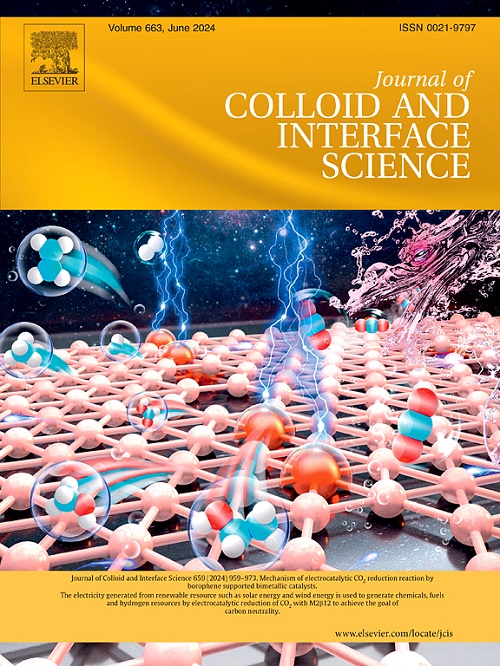Ionolamellar liquid crystal of G-quadruplex in a protic ionic liquid
IF 9.7
1区 化学
Q1 CHEMISTRY, PHYSICAL
引用次数: 0
Abstract
Hypothesis
G-quadruplex structures, assembled from guanosine (G) or its derivatives, are significant for their close association with biological processes and their capacity to serve as good templates for constructing functional materials, but the research and applications of G-quadruplex structures are mainly confined to aqueous solutions (in water).
Experiments
We report the experimental evidence of an ionolamellar liquid crystal of G-quadruplex assembled from underivatized guanosine, induced by metal ions (K+, Na+, Ca2+ and Sr2+) in a protic ionic liquid (ethylammonium nitrate). The stacking mode of G-quartets varies with borate ester content and the ratio of borate ester to guanosine (RB/G) for K+, while remaining unchanged for Na+. For Ca2+ and Sr2+, the stacking mode is also changed by excess divalent metal ions, leading to chiral inversion with changing concentrations of guanosine, and exhibiting strong affinity for borate ester to stabilize G-quadruplex. Ionolamellar liquid crystal displays ionic conductivity, κ = 7.20 and 9.96 mS·cm−1 for mono-and di-valent ions, respectively.
Findings
These results advance our understanding of the structures of G-quadruplex and the role of dynamic borate esters in ILs, and may offer a new option to design the ionolamellar liquid crystal and electrolytes for biomedical devices.

质子离子液体中g -四重体的离子层状液晶
由鸟苷(G)或其衍生物组装而成的假说四重结构与生物过程密切相关,并且可以作为构建功能材料的良好模板,但G四重结构的研究和应用主要局限于水溶液(在水中)。实验:本文报道了在质子离子液体(硝酸乙胺)中,由K+、Na+、Ca2+和Sr2+金属离子诱导的未电离鸟苷组装成g -四重体离子层状液晶的实验证据。对于K+, G-四合体的堆叠模式随硼酸酯含量和硼酸酯与鸟苷的比值(RB/G)而变化,而对于Na+, G-四合体的堆叠模式不变。对于Ca2+和Sr2+,过量的二价金属离子也改变了它们的堆叠模式,随着鸟苷浓度的变化导致手性反转,并且对硼酸酯具有很强的亲和力来稳定g -四联体。离子层状液晶显示离子电导率,单价离子和二价离子的κ分别为7.20和9.96 mS·cm−1。这些结果促进了我们对g -四联体结构和动态硼酸酯在il中的作用的理解,并可能为设计用于生物医学设备的离子层状液晶和电解质提供新的选择。
本文章由计算机程序翻译,如有差异,请以英文原文为准。
求助全文
约1分钟内获得全文
求助全文
来源期刊
CiteScore
16.10
自引率
7.10%
发文量
2568
审稿时长
2 months
期刊介绍:
The Journal of Colloid and Interface Science publishes original research findings on the fundamental principles of colloid and interface science, as well as innovative applications in various fields. The criteria for publication include impact, quality, novelty, and originality.
Emphasis:
The journal emphasizes fundamental scientific innovation within the following categories:
A.Colloidal Materials and Nanomaterials
B.Soft Colloidal and Self-Assembly Systems
C.Adsorption, Catalysis, and Electrochemistry
D.Interfacial Processes, Capillarity, and Wetting
E.Biomaterials and Nanomedicine
F.Energy Conversion and Storage, and Environmental Technologies

 求助内容:
求助内容: 应助结果提醒方式:
应助结果提醒方式:


